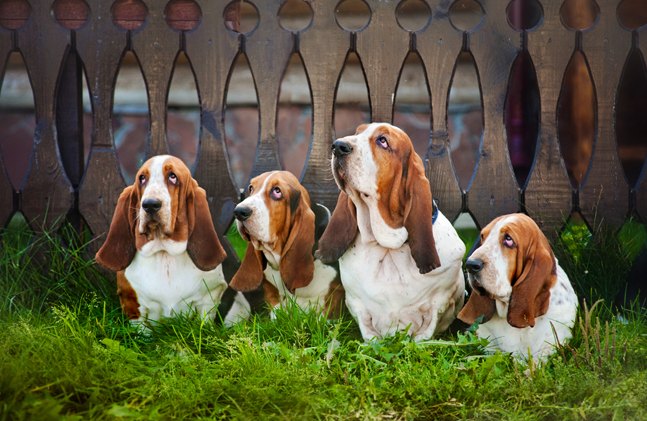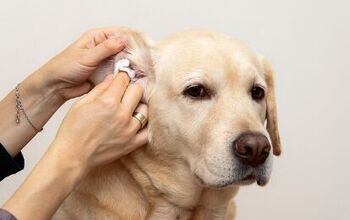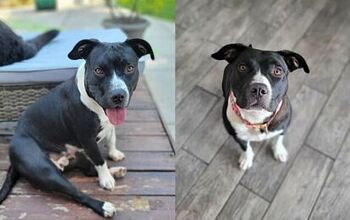Basset Hound


About Basset Hound
Elvis didn’t know what he was talking about – the Hound Dog, aka the Basset Hound, will be a friend of yours forever. You can’t resist those awww-inducing eyes, floppy ears and hangdog expression.
The only living descendant of the earliest scent hounds, the Basset Hound is a smooth, short-coated dog, with a long, heavy body and wrinkly, short stout legs. Used for badger hunting and trailing rabbits, this dog is easygoing, good natured, and gets along with children and other pets. This dog may move slower than other breeds, but it still needs daily exercise. With a love for sniffing and following trails, this breed will let you know that it is on to something with a loud howl. Even if you don’t plan to track anything, the Basset Hound makes a wonderful family pet. Read on to find out more.
The Basset Hound is a smooth, short-coated dog, with a long, heavy body and wrinkly, short stout legs.
History reveals little about the Basset Hound until around the 1500s, when the breed was first referred to as a badger hunter. Early Ardennes hounds were brought to Britain in 1066 during the Norman invasion, when the breed was used in packs to hunt stag. The name Bloodhound was given to this imported dog, transforming the Belgian hunting dog into one the most well-known tracking dogs, thanks to its keen sniffer. In later years, this breed was mixed with other dogs to boost its size.
As the Basset Hound began to gain popularity, notable admirers ranged from King Edwards VII to Shakespeare. The common man used this breed for hunting as they needed to use dogs they could follow while on foot.
This Basset Hound has been bred over centuries so its owners can follow the dog on foot while it hunts through dense cover for badgers, rabbits, and hares. Early documentation shows the breed originated from the old St. Hubert hounds, which were the hunting hounds of the abbey of St. Hubert in the Ardennes. Four different versions of the Basset Hound were developed, but it’s the Basset Artesien Normand that most looks like the present-day Basset Hound. In the 1800s and the 1930s, Bassets were crossed with Bloodhounds to increase its size.
The Basset Hound was recognized by the AKC in 1885.
Choose a high-quality dog food appropriate for your Basset Hound’s age, as it contains all of the nutrients that your dog needs. Refrain from feeding your dog table scraps, because they don’t contain appropriate nutrients and the empty calories can lead to weight gain, obesity, and digestive problems. It can also lead to bad eating habits and bloat, which is a serious condition that may occur in dogs with deep chests. You should feed your dog two or three small meals a day, and if it your dog gulps its food down, consider using a slow feed dog bowl to slow it down.
The Basset Hound is easy-going, good natured, and gets along with children and other pets.
Don’t expect quick results when training your Basset Hound – this breed won’t learn unless it has a good reason to. You need to show your dog why it must learn and make training fun. This doesn’t mean this breed isn’t a smart dog – it just may take some time to break through its resistance. Once you start making progress, you’ll find training to be much easier.
Above all, consistency and patience is important when training the Basset Hound. If you are training your dog for the hunt, be aware that once it catches a whiff of its prey, your Basset Hound won’t stop for anything… even its owner. Basset Hounds respond well to gentle and patient training with lots of love and kindness, with positive reinforcement as it learns commands.
A natural pack animal, the Basset Hound enjoys being part of a team. You need to be the alpha leader that lets the dog know what is acceptable.
Male Basset Hounds weigh 30 to 65 pounds, while females weigh 20 to 55 pounds.
Sweet and gentle, the Basset Hound is easy going, which is why it makes such a great family dog. A naturally well-behaved dog, this breed tends to be affectionate with its owner, along with children. You also notice how it gets along with everyone, including other dogs and animals.
Loving and cuddly, this dog may become your shadow. In fact, it may even start to think that it is a lap dog! You’ll never be lonely with a Basset Hound in your house.
A major concern with the Basset Hound is obesity because of the strain it puts on the intervertebral disks. Other health concerns for the breed are foreleg lameness, OCD, ectropion, otitis externa, intervertebral disc disease, intervertebral disks, Glaucoma, von Willebrands, gastric torsion and foot cysts. Bloat may also be a concern with your dog, which may result in possible lameness, paralysis and even death.
Basset Hound dogs have a life expectancy of 8 to 12 years.
It may be a little slow, but your Basset Hound needs exercise on a regular basis as it tends to gain weight. Lack of exercise causes obesity, creates stress on the joints and bones, and will allow the dog to slip into a lazy lifestyle. It is important to physically and mentally challenge your Basset Hound.
Sweet and gentle, the Basset Hound is easy going, which is why it makes such a great family dog.
The American Kennel Club says this about the breed: “Instantly recognizable due to its big, heavy body, short legs and long ears, the Basset Hound has proven itself to be a multi-purpose dog that excels in conformation, obedience, tracking, field trialing and pack hunting. The breed is known for its strong hunting instinct and, if given the opportunity, will chase or follow a scent willingly.”
The Basset Hound’s coat is short, heavy, and smooth, with little grooming requirements. A brushing once or twice a week removes any dead dander hair, while keeping the skin exfoliated. During heavy shedding cycles, the hair will need to be removed by brushing and bathing.
Long ears on a Basset Hound puppy are hard to resist. Remember that it will take more training with this puppy, so you must be willing to work consistently with your Basset Hound right from the start. As well, a Basset Hound puppy shouldn’t be given too much exercise, as it causes stress on its joints.
Photo credit: Ksenia Raykova/Shutterstock

Amy Tokic, Editor of PetGuide.com, is a passionate animal lover and proud pet parent of Oscar, a Shih Tzu/Chihuahua cross, and Zed, a Japanese Chin. Her love of animals began in kindergarten, when she brought her stuffed dog Snoopy into class with her every day. Now, she writes about her adventures in pet ownership and tirelessly researches products, news and health related issues she can share with other animal enthusiasts. In her free time, Amy loves perusing used book and record stores, obsessing over the latest pet products available and chasing squirrels with wild abandon (a habit attributed to spending too much time with her pooches).
More by Amy Tokic

























